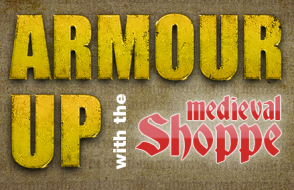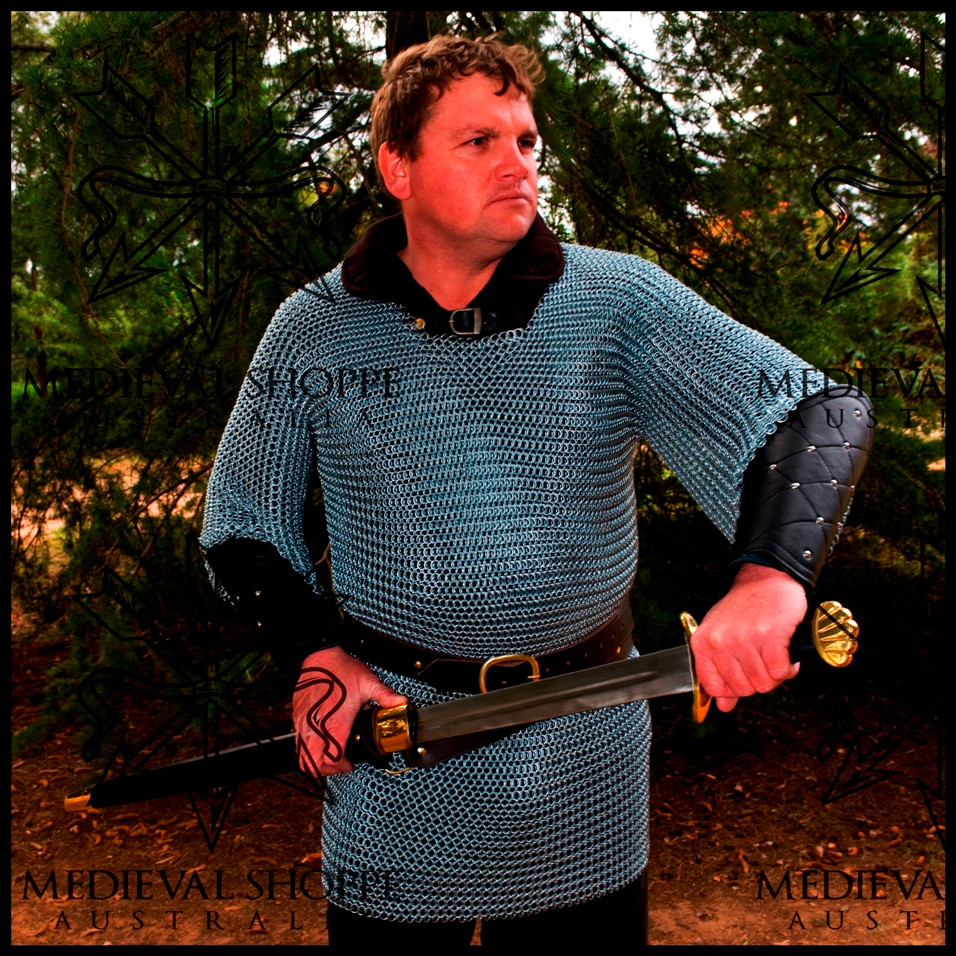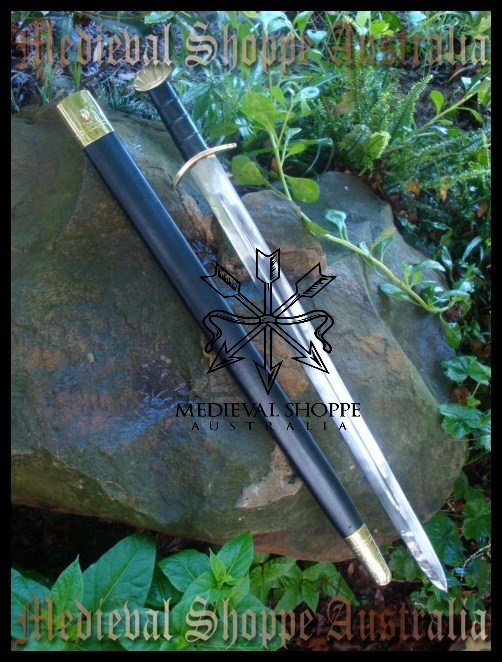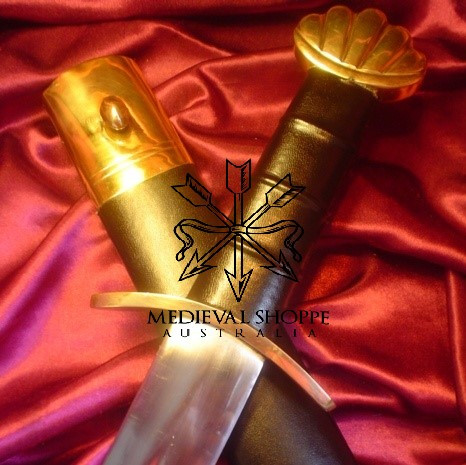-
Product Description
..
Traditionally Made, Heirloom Quality
_____________________The history of the sword has given us many designs that are unique, and readily associated with a particular time, place, and culture. Even people who are unfamiliar with the subject will recognize a Scottish basket-hilt, a musketeer's rapier, or the Japanese samurai's katana. One of the most distinctive sword types extant has come to us from the period commonly called the Viking Age. This is a period recognized by scholars as being roughly from 750 A.D. to 1100 A.D. This was an evolutional period between the migration era and what we have come to know as the Middle Ages. The Viking Age saw the transition from composite hilts constructed of non-ferrous metals, and organic materials, to far stronger hilts fashioned from iron. The change from pattern-welded blades to homogenous blades, or those made from one type of steel, also occurred during this period. At the beginning of the Viking Age swords featured a pattern-welded blade that was mounted on a complex and relatively fragile hilt. These swords were exclusive to Chieftains and the great warriors in their service. The hilts were elaborately mounted with precious stones set in gold, and other lavish embellishments, that perhaps contained religious significance. By the end of the age these beautifully constructed, but ungainly, swords had been replaced by swords with better blades and stronger hilts. The point-heavy blades of the great migration gave way to sleeker tapered blades that featured improved handling characteristics.
Measurements and Specifications:
-
Weight: 2 pounds, 8 ounces.
-
Overall length: 36 1/2 inches.
-
Blade length: 30 1/4 inches.
-
Blade width: 1 7/8 inches at base.
-
Grip length: 4 1/4 inches.
-
Point of Balance: 5 1/2 inches from guard.
-
Center of Percussion: 19 1/2 inches from guard.
This Viking Sword is based on several swords that date from the tenth century, late in the Viking Age. The most famous of these is a sword that is housed in the British Museum in London. This sword is possibly the most recognizable survivor from the Viking Age. Photographs of it have been featured in nearly every book dealing with Viking arms. (Shown on pages 77-79 in Swords of the Viking Age, as well as pg. 26, X.8, of Oakeshott’s Records of the Medieval Sword.) This excellent sword was found in the River Witham opposite Monks Abbey, Lincoln, England in October 1848. This sword was our main inspiration. It shares the Witham sword's sleek lines and bold proportions. Our hilt design is a variation of Petersen's Type S, as well as Wheeler's Type 6. The blade design is categorized as a Type 4 in the Geibig typology. This type is found from the mid-tenth century through the mid-eleventh century. The blade features a moderate taper with a fuller that runs almost the length of the blade, and follows the same degree of taper as the blade's profile. Type 4 blades tend to be shorter, and narrower, than their earlier counterparts. In this sense, this sword is a variation instead of a pure example, since it is larger than the standard Type 4. This should not be seen as a point of contention since the swords on which it is based are larger than the norm, for the type.
This is a visually striking sword, and a key feature of this is the sword's pommel. The grip has been fashioned from two halves of stabilized birch that has been hollowed out to accept the blade's tang. A central cord riser is then added to the grip for visual detail, and as an aid in gripping. Finally, the grip is covered with thin leather that is glued into place. The completed assembly results in a finished grip that is well proportioned and aesthetically pleasing. Its lower guard is a simple solid brass curved design.. There is no perceptible movement in any of the hilt components. Everything is tight and secure. The blade is cleanly finished, and very nicely finished. The fuller's profile is sharp and crisp, with no wandering or drifting of its outer edges. The blade features an edge geometry that is acute yet substantial enough to give good service. This edge would have been more than sufficient against the mail byrnies and wooden shields in use during the tenth century. Its blade would have done well against the lightly armored warriors of the Viking Age. Viking swords have been described as "big butcher knives!" I feel that this is a very apt description. Our Viking Sword features a blade that is broad yet thin in cross-section. This design allows for a blade that is an efficient cutter yet still retains the necessary mass for strength, as well as impetus during the cut. The blade is topped off with a serviceable point that would have been effective against the typical body defenses of the period. In spite of this, however, the blade is still a dedicated cutter. The cut was the preferred offensive technique of the period and the design shows this. I used the traditional Japanese cutting medium of rolled, and water-soaked, tatami mats for my cutting exercises, and find that this sword tracks well into and out of the cut. The sword is also responsive in thrusting maneuvers. It’s an agile and efficient cutter that strikes with authority. The sword's grip may be considered by some to be too long. We have been educated to believe that Viking sword grips were very short. However, when examining the grip lengths of the swords listed in Swords of the Viking Age it will be seen that its grip is well within the historic parameters of the type. I utilize both the typical "hammer" style grip, as well as the "Viking" method of palming the sword's pommel. I found that both methods gave satisfactory, though very different, results. When using the hammer grip very powerful chopping blows were possible. This is a technique that would have been effective in the close press of a shield wall, where broad movements aren't possible. When palming the pommel longer range slashing cuts were the norms. I used the sword in conjunction with a Viking pattern shield during these exercises, and I found that the palming method allowed for a longer reach while still maintaining cover behind one's shield.
-
-
Product Reviews
-
Magnificent Replica.
I have purchased many items from this seller and all the items exceeded my expectations.
This replica Viking sword is no exception it is magnificent, I could not have wished for a better
sword. Great weight and well balanced. It looks high class with the gold accents on the pommel and scabbard it is absolutely beautiful. Very happy with the customer service from this store it is second to none, very helpful and courteous and trust worthy. A great all round shopping experience with quick dispatch and delivery. Kenneth Charles Bolewski on 3rd Apr 2023 -
Viking sword
Great work love the product thankyou again Unknown on 2nd Jul 2020
-
River Witham Viking Sword
I am very happy with this sword, well made and fast delivery at a great price.
Cheers Arthur on 26th Jun 2018 -
Perfect Product
The Viking sword was exactly as described - heavy, beautiful settings, a great display or re-enactment weapon. Delivery was free and fast. I do think Aus Post might have banged the package a couple of times as there were some marks on the metal fixtures, but I think it adds to the "authentic" feel of the sword.
I like that the blade was already oiled and wrapped separately. Danielle on 19th Oct 2016 -
Very pleased!
Beautiful sword, the stitching on the leather wraps are great. Only a few minor cosmetic blemishes (I'm assuming from shipping) but nothing that effects the swords performance. I would recommend this sword to anyone for its functionality and affordability! Unknown on 24th Apr 2016
-
-
Product Videos
-
 Sword Fighting As It Was For the VikingsViking fight choreographers Kelle and Gernot Longbow reenact v...
Sword Fighting As It Was For the VikingsViking fight choreographers Kelle and Gernot Longbow reenact v... -
 How to hold the Viking era sword - maybe Reply to Scholagladiatoria / Matt EastonThrand Replies to Scholagladiatoria or Matt Easton about holdi...
How to hold the Viking era sword - maybe Reply to Scholagladiatoria / Matt EastonThrand Replies to Scholagladiatoria or Matt Easton about holdi... -
 VikingSwordClassic viking sword
VikingSwordClassic viking sword
Sword Fighting As It Was For the Vikings
Viking fight choreographers Kelle and Gernot Longbow reenact viking warfare in an authentic way. In this video they show you how. The Vikings claimed that their swords were indestructible. That's probably a bit of a stretch. But they must have been nearly indestructible to allow the Vikings to wreak so much havoc and destruction. This webisode is connected to our full episode Inside the Berlin Island Museums (Pergamon and Neues) where there is a longer segment on viking swords. Stream every episode of Museum Secrets at Vimeo On Demand: http://vimeo.com/ondemand/museumsecrets and VHX: http://museumsecrets.vhx.tv/ MUSEUM SECRETS is a hit TV series and rich media website that travels to the world's extraordinary museums, revealing the stories of irreplaceable treasures, probing familiar legends and assumptions, and using cutting edge research and technology to investigate the unknown. The series is produced by Kensington Communications Inc. for History (Canada) and is narrated by acclaimed actor, Colm Feore. You can also buy MUSEUM SECRETS Volume 1 on DVD: http://kensingtontv.com/store/store_browse.php?projectdisplay=ms Website: http://www.museumsecrets.tv Facebook: http://www.facebook.com/museumsecrets Twitter: http://www.twitter.com/museumsecrets YouTube: http://www.youtube.com/museumsecrets Flickr: http://www.flickr.com/photos/museumsecrets Tumblr: http://museumsecrets.tumblr.com/ Google+: https://plus.google.com/u/0/106512282068242238435/posts -















